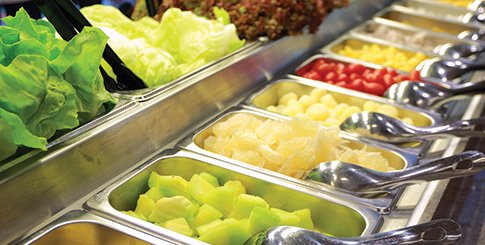Jenkins of Labatt often sees ease of use and fresh enhancements trumping sustainability. “Most people want packaging that breathes better and tears less. Biodegrad-able and recyclable are not big factors.”
Challenges: Big & Small
The nature of foodservice makes food safety a significant challenge. According to Kane, “Concerns about food safety are more prevalent because of the linear way in which it affects the end user. Because foodservice has some of the highest ‘touchpoints’ when it comes to food handling, we work with growers, shippers, and our distribution network to apply up-to-date third-party audits, and the most advanced processes and procedures.”
Chris Kragie is an owner at Western Fresh Marketing in Madera, CA that sells figs, kiwifruit, Asian pears, pomegranates, Hawaiian papaya, and fresh ginger. “The bar on standards keeps being raised,” Kragie says. “Most of the pressure is on growers, and we’ve had to let some of the smaller ones go because the costs of meeting food safety standards are so high for them.”
“Food safety is always a concern,” reit-erates Overdorf, “no matter the venue. Obviously, throughout the processing operation, there are more opportunities for contamination. Once an item has been cut or handled, there is more exposure to oxygen and the cells will break down more quickly.”
“Distributors and operators have their own requirements and guidelines,” weighs in Hilowitz, “as well as those outlined by regulatory parties. Today, customers are more focused on sourcing bulk items that have been processed within good manufacturing practices to ensure food safety, instead of sourcing raw ingredients and processing them themselves.”
Other components affecting food safety include distance and weather. “We buy some product off the Los Angeles and San Francisco markets,” shares Baldor’s Muzyk, “then it has to be trucked and ultimately flown east. We pick up containers from John F. Kennedy airport all the time, and so many things can go wrong—yet we manage to do it successfully every day.”
Every level of the industry struggles with the capriciousness of weather, and foodservice is no exception. “Last year, Yuma experienced high temperatures early in the season—everything grew too fast, then there was cold and rain so the season ended early,” Jenkins recounts. “Salinas had to replant weeks late and that sent us scrambling for romaine. Since Salinas wasn’t ready, we had to buy from Mexico. Schools don’t tell you what they need until the last second—an order for strawberries can go from 800 cases per week to 2,000 cases. Hopefully, conditions will cooperate.”
Communication, of course, is pivotal. “Because of the constant changes in market conditions across all growing regions,” remarks Kane, “we work on keeping relevant information in front of our customers to keep them aware of how this could affect their planning.”



